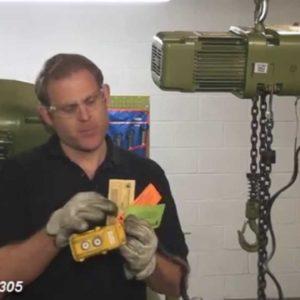Hi, I’m Pat Clark with lifting gear hire
corporation And today, we’re discussing troubleshooting
ideas surrounding our electric chain hoist Start with the basics first when do receive
a call from one of our customers In regard your electric chain hoist It usually due to one culprit and that is
an inferior power source We do everything we can to inform you the
proper voltage and amps required to Power the hoist In fact when we deliver the hoist you’ll
notice on the pendant an affix Are some reference materials specifically
this one points out the proper gauge And length extension cord that’s utilized
to power one and two ton electric chain Hoists In fact at full load and running on 115 volts This can see amps as high as 24 we also offer
hoists Ranging in capacity from two-and-a-half all
the way up to ten ton And could be wired for either 220 or 440 volts If it is wired for 220 you can see an amps
as high as twenty-five If its wire for 440 you can see amps as high
as 13 So in summary you want to make sure you check
all the power sources that lead up to The hoist itself You may have noticed we take deliver the hoist
we ship the controls And the power source separately on our one
and two ton electric chain hoist Will supply you with the cord and the appropriate
size 115 plug on a large Units they are supplied with the 220 or 440
volt will supply you with the whip That has the exposed wires It’s your responsibility find the appropriate
size OSHA plug And fit up accordingly to connect them Grab the plug find a notch Matchup with its male female counterpart screw
in the power plug Grab the panama core and repeat the same procedure And now you’re ready to try the hoist So you're checking the hoist grab the control
pendant and if you to Press Up on the hoist and the hoist moves down or
if you press down on the hoist Hoist moves up you may have your leads reverse Want to reach of those connections and then
retest again you may also Experience the hoist Inability to lift at the rate of capacity
or Improper lifting or lowering speeds first
you need to check to make sure That whatever you're looking Is the appropriate the capacity hoist you’re
working with also you may have Experienced a loss or drop in voltage Either way you're going to have to check on
a man one or both Also pertaining to power if your hoist is
making a loud buzzing or humming Sound or is clicking It may be trying to get more power to the
hoist again you're going to have to Check your connections in your cords Because these hoist are electric they have
a duty cycle specifically 25 Percent meaning that out every hour You can count on being able to use the hoist
for about 15 minutes the hoists are Engineered and designed to stop working And allow themselves to cool down when they're
overheating to prevent this down Time we ask you to follow a few steps First and foremost as mentioned earlier make
sure you have the appropriate size Gauge length and power That’s actually supplied to the hoist next
decrease the frequency of your lifts Then lastly make sure that you decrease the
weights of the loads that you’re lifting Or hoisting These electric chain hoists have an electromagnetic
brake on the Inside It’s designed to stop of hoisting operations
when you're not using the Pendant or there's no power to hoist at all However if when the powers of the hoist continues
to run You must give us a call immediately like if
your hoist says the ability to lift but Not lower or vice versa Let’s start with something rudimentary we
want to make sure that our limit Switches are not engaged Also depending on the length the rental or
fewer in an area with high Vibration You may experience some other wires on the
interior or the back of the pendant Become loose if that's the case you want to
ensure the powers off Remove the housing and inspect any loose wires There or on the back of the pendant before
we finish up would like to remind you A few safety guidelines It’s important to never use the hook just
and the chain is a sling itself doing so Can cause deformation of the hook And damage the chain addition we're loading
the hook It’s important not to point load it the
hook is engineered and designed To the form to prevent overloading and catastrophic
failure Is a good alternative choose a piece of hardware That can take safely Rust at the bottom of
the hook in addition on these multi chain blocks we Want to make sure we don't Capsize the hoist block itself in doing so Can cause kinks in the chain on Thank you for watching this troubleshooting
video we hope that you Find it helpful For more questions regarding electric chain
hoist and other products that That we rent Give us a call as a reminder the content in
this video are for informational Purposes only Please consult the manufacturer's guidelines
and use and care instructions Before beginning


